×
The Standard e-Paper
Home To Bold Columnists

NAIROBI: Father Mutuku Daniel; my parish priest once visited West Africa in company of his fellow Kenyan priests and some nice soup was served as an appetiser at lunch break. They enjoyed the soup until they asked what it was made from.... your guess is as good as mine. It is said that those who know how sweet a snail is will salivate, but those who don’t know feign nausea at its slime.